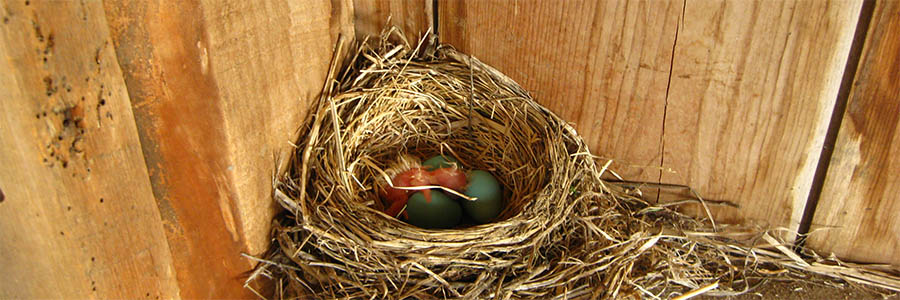Belted Kingfisher (Megaceryle alcyon)
The Belted Kingfisher is a year-round resident of the prairie region, although it ranges to the north well into Canada during the summer and breeds there, and many kingfishers overwinter in Mexico and Central America. They generally live near water, since their principal diet is small fish and crayfish. They nest in burrows that they dig into earthen banks by water. They must winter where the water does not freeze so they can continue to feed on aquatic life, which they take by diving into the water. The birds are stocky with a distinctive large and crested head, short legs, and medium length tails.
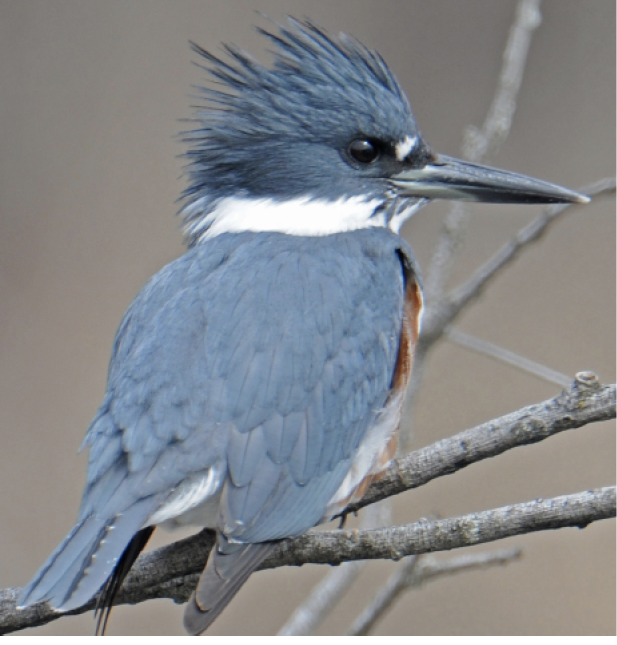
Photo courtesy of Ken Saunders II, taken March 21, 2011, at Hendrickson Marsh on the boundary between Marshall and Story counties, Iowa
Song: Male and female belted kingfishers give strident, mechanical rattles in response to the slightest disturbance. When threatened they may give screams, which males sometimes combine with harsh calls. (Description adapted from text created by the Cornell Lab of Ornithology)
Click the icon below to hear an audio recording of the Belted Kingfisher, recorded by Jonathan Jongsma at Lake Bemidji State Park, Beltrami, Minnesota, for Xeno-canto.
American Goldfinch (Spinus tristis)
The state bird of Iowa, the American Goldfinch, is a small bird with a conical bill, a short, notched tail, and a long wingspan. It feeds on sunflower and nyjer seed, and often flocks with Common Redpolls during the winter months. In the spring, males are bright yellow with a black forehead, while females are olive colored above their tail and pale yellow beneath. In the winter, these finches turn a dull brown with black wings. Their call is high pitched, and often given during flight. The American Goldfinch lives in fields and floodplains, especially around plants such as asters and thistles, as well as in orchards and backyards. While common in the prairie region, it can be found all across the country and is also the state bird New Jersey and Washington.
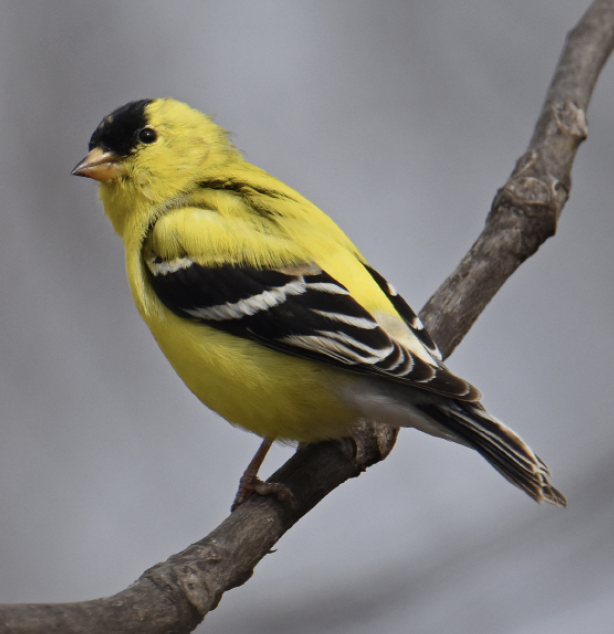
Photo courtesy of Ken Saunders II, taken April 12, 2015, at the Sugar Creek Audubon Nature Sanctuary in rural Jasper County, Iowa
Song: Males sing a long and variable series of twitters and warbles that can be several seconds long. The notes and phrases are variable and repeated in a seemingly random order. Birds continue to learn song patterns throughout life. (Description adapted from text created by the Cornell Lab of Ornithology)
Click the icon below to hear an audio recording of the American Goldfinch recorded by Greg Irving at Nelson Lake Marsh Reserve, Kane County, Illinois, for Xeno-canto.
Downy Woodpecker (Picoides pubescens)
The Downy Woodpecker is a common sight across North America all year round on tree branches and trunks or tall weeds and grasses. Both males and females have checkered black and white wings, but only the males have a patch of red feathers on the top of their head. Keep an eye out for them in the prairie and near open woodlands, particularly deciduous trees.
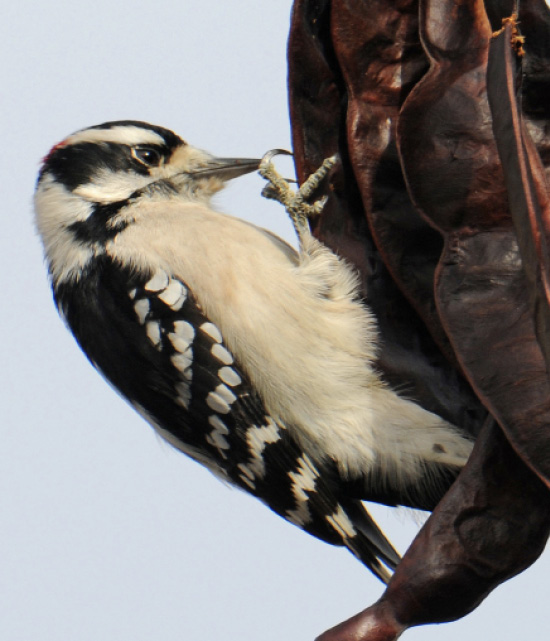
Photo courtesy of Ken Saunders II, taken November 1, 2009, at Rock Creek Lake State Park in Jasper County, Iowa
Song: The Downy Woodpecker’s whinnying call, made by both sexes, is a typical sound of deciduous forests during the breeding season, along with drumming noises they make with their beaks to claim territories and attract mates. It’s a somewhat excited string of hoarse, high-pitched notes that descend in pitch toward the end; the call lasts about two seconds. Excited birds also give a very sharp pik note, occasionally repeated several times. (Description adapted from text created by the Cornell Lab of Ornithology)
Click the icon below to hear an audio recording of a drumming Downy Woodpecker, recorded by Jonathan Jongsma at Bear Head Lake State Park, St. Louis, Minnesota, for Xeno-canto.
Tufted Titmouse (Baeolophus bicolor)
The little gray Tufted Titmouse is common in eastern deciduous forests and a frequent visitor to feeders. The large black eyes, small, round bill, and brushy crest gives these birds a quiet but eager expression that matches the way they flit through canopies, hang from twig-ends, and drop in to bird feeders. When a titmouse finds a large seed, you’ll see it carry the prize to a perch and crack it with sharp whacks of its stout bill. Tufted Titmice are acrobatic foragers, if a bit slower and more methodical than chickadees. They often flock with chickadees, nuthatches, and woodpeckers and are regular visitors to feeders, where they are assertive over smaller birds. Their flight tends to be fluttery but level rather than undulating.You’ll find Tufted Titmice in most eastern woodlands below 2,000 feet of elevation, including deciduous and evergreen forests. Tufted Titmice are also common visitors at feeders and can be found in backyards, parks, and orchards.
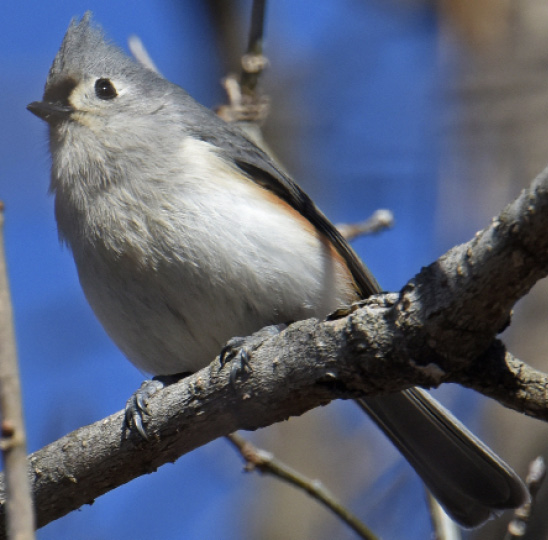
Photo courtesy of Ken Saunders II, taken March 7, 2015, at Red Rock Recreation Area, near Pella in Marion County, Iowa
Song: The Tufted Titmouse’s song is a fast-repeated, clear whistle: peter-peter-peter. The birds repeat this up to 11 times in succession or up to 35 songs delivered per minute. Females occasionally sing a quieter version of the song.(Description adapted from text created by the Cornell Lab of Ornithology)
Click the icon below to hear an audio recording of a Tufted Titmouse, recorded by Eric DeFonso at the Konza Prairie Nature Preserve, Riley County, Kansas, for Xeno-canto.
